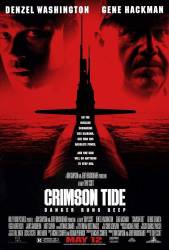Factual error: When the Captain (Gene Hackman) is getting ready to address the crew, the Chief of the Boat (an enlisted man) is briefly shown barking orders to the crew wearing a combination cover with an officer's golden chin strap. A Chief Petty Officer wears a black chin strap. Contrary to popular belief, it's not illegal to wear an accurate uniform on film, in fact the military offer their help to ensure uniforms are accurate: http://www.defenselink.mil/news/NewsArticle.aspx?ID=516, so that's not the reason. (00:15:41)
Factual error: Upon the order to dive the boat when leaving port, many of the crew are shown hurrying around (especially up and down ladders). Everyone would already have a place to be on the maneuvering watch. (00:18:30)
Factual error: You don't wear your working uniforms underway. You all have coveralls on, both officers and enlisted. (00:18:30)
Factual error: Throughout the movie, everytime some type of casualty occurs or an alarm sounds, police type lights go off throughout the ship. Submarines don't have flashing lights or grated decks for that matter throughout the ship. The sound of the alarm is enough, since there are no deaf personnel on board a submarine. (00:23:10)

Factual error: Several times during the movie, we can see the radio operator with the screen contents "printed" on his face. As everyone knows, that just doesn't happen in real life. (00:25:00)
Factual error: Throughout the movie, all sorts of messages are passed over the 1MC (ship's intercom) when the boat is supposed to be stealthy. They've set "Ultra Quiet" to avoid the enemy sub but no-one was any quieter, and everyone was still using the 1MC. Worse, people are shouting commands and status updates, both in person, and over the intercom! No wonder that Akula found them. The only thing protecting this ship was plot armor! In real life, messages would be passed quietly using sound powered phones (which we also see), rather than blasting the info loudly to the entire crew, because sonar will literally pick up the sounds of loudspeakers and people shouting. Let's not even mention classified target data being passed to the entire ship's crew on the 1MC. (00:49:00)
Factual error: Many times the Captain is wearing a red baseball style cap. This is only worn by the Captain when drill is underway to signify, "I'm here, but not really here for the purpose of the exercise." (00:58:20)
Factual error: After removing him from command, Ramsey reviews Hunter's record, which says that Hunter was last stationed on the USS Alaska, SSBN-723. The USS Alaska is actually SSBN-732. (01:00:50)
Factual error: After the 2nd sub attack, while Hunter is in charge, a call is made from conn to maneuvering, to restore propulsion as soon as possible. It shows a young black dude answering back on the MC, having to yell over the noise of water spraying everywhere. This was laughable. Maneuvering is the control room for the nuclear power plant. It's all control panels and 4 technicians plus the EOOW, a nuclear-trained officer or senior enlisted, who would be answering back to conn. There wouldn't be any flooding going on there. (01:09:45)
Factual error: At one point, the US sub's starboard (right) side is shown to have an American flag painted on the hull near the bow. The flag's blue field is at top/left when on this side of any vehicle, it should be at top/right. Proper display of the flag requires the blue field always be located 'forward' of the remainder of the flag on all vehicles, be they plane, boat, tank or even space shuttle. (01:19:15)
Factual error: Throughout the combat sequences with the Russian submarine, both the enemy sub and the missiles exchanged between the USS Alabama and the Russian sub are shown as blips on a radar scope. In real life, sonar displays look much different and resemble a "waterfall" pattern that trained sonar specialists can read.






Suggested correction: Coveralls did not become the primary uniform underway until the NWU Type I was found to melt, which was post 2010. Prior to that, enlisted wore the blue two piece working uniform, and officers and chiefs wore khakis.
Not true. I'm a veteran of 10 ssbn patrols during the 80s and 90s. Everyone wore coveralls, and that included all ranks up to and including the captain. However, coveralls weren't required. My second captain always wore khakis. We wore them because they were more comfortable and functional than dungarees and khakis.